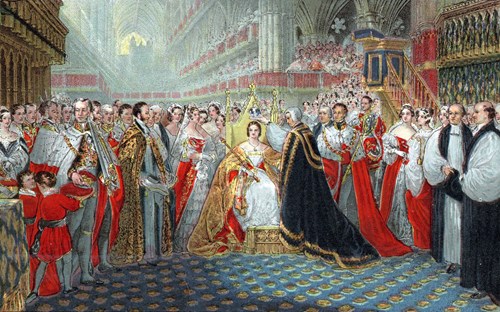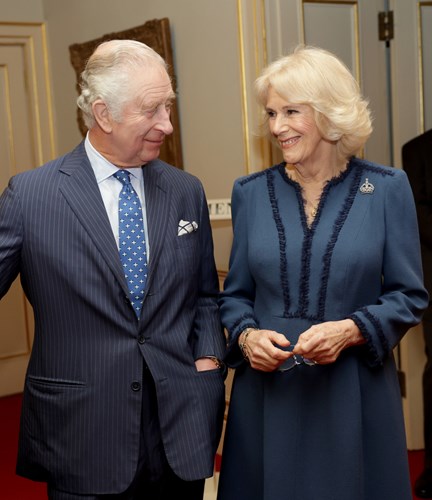Claim learners’ certificates by Friday 11 July. If your qualification doesn’t include an external assessment and learners are expecting results in August, make sure to claim certificates by this date. For qualifications with external assessments, claim within two working days of receiving confirmed results. Find out more on our timely delivery of results page.
An ancient spectacle for a modern world: which traditions will we see at the coronation?
In a magnificent procession last week, the Stone of Scone – or the Stone of Destiny – arrived at Westminster Abbey from Edinburgh castle, one of the oldest fortified castles in Europe.
Over seven hundred years ago, the stone was synonymous with the Kings of Scotland, but it was seized in 1296 by Edward I of England, who commissioned an oak coronation chair to hold the stone, symbolising English sovereignty over Scotland.
On Saturday 6 May, it will play a ceremonial role in the coronation of Charles III, as he becomes part of seven hundred years of tradition that is the tapestry of English monarchy.
From 1066 to the present day, thirty-nine monarchs of England have sat beneath the vaulted ceilings and gothic rose stained glass windows of Westminster Abbey, and from 1300, they have sat in that same coronation chair, above the same stone.
For the coronations of English Queens and Kings is history in the making, from ancient times to the present, in a ritual that embodies seemingly timeless traditions.
Which traditions will remain, and which will change?
The coronation is a royal spectacle that few will see more than once in a lifetime, and it would be inconceivable to a modern audience that such an event was throughout history utterly inaccessible to the public. But prior to the reign of Elizabeth II, only the nobility of the realm and esteemed guests could glimpse the lavish ceremony with its sacred traditions, which have survived the centuries.
The role of the nobility – once an integral part of the proceedings – has much diminished over the centuries, but they have always played an important part in ushering in a new monarch, a tradition Charles III will uphold. The title of the Duke of Norfolk, one of the premier nobles of the realm, has been held by the Howard family since 1483, with each duke having served as Earl Marshal for coronations, weddings, and funerals for over five hundred years – another tradition Charles III will continue.

An image depicting the coronation of Queen Victoria in 1837
The current Earl of London will continue the centuries-old tradition of carrying the Golden spurs, a symbol of the sovereign’s role as head of the armed forces, as will the Marquess of Anglesey, Duke of Westminster, Earl of Caledon, and Earl of Dundee, who will carry the Quarterings of the Royal Arms.
Francis Dymoke, whose family has served as the King or Queen’s Champion since the Middle Ages, will thankfully not have to uphold the tradition of riding on horseback into the Coronation Banquet and challenge any who doubt the right of The King or Queen to the throne(!) – but rather, will modestly carry the Royal Standard.
There are many examples of how the coronation ceremony has evolved or modernised over the centuries. Where once only the Peers of the Realm would stand witness, coronations today are by invitation only – 2,000 invitations have been issued – but the full event will be broadcast around the world to millions of viewers.
Actors, artists, athletes, singers and designers will mingle with the European Royals, along with representatives of governments of the Commonwealth and other countries. Thousands will line the streets as the royal carriage processes from Buckingham Palace to the Abbey for the actual ceremony, which includes the Recognition, followed by the Anointing, then the dressing of the monarch in the robe of cloth of gold (called the Supertunica) and the Imperial Mantle.
These parts of the ceremony rooted in tradition mark the religious significance of the coronation, which have remained almost unchanged throughout the ages. After the anointing, Charles will receive the Coronation regalia – the St. Edward's Staff, sword, Sovereign's Orb, the twelfth century Coronation Spoon, two Sovereign's Sceptres, spurs and armills – before the moment of crowning.
In keeping with tradition, Charles will reuse vestments worn by George IV in 1821, George V in 1911, Charles’ grandfather, George VI in 1937 and his mother, Elizabeth II in 1953.
Finally, St Edward’s Crown – the solid gold iconic crown which dates back to the 17th century and weighs almost three kilos – will be placed on Charles’ head by the Archbishop of Canterbury, crowning him as King Charles III.
The fact that the public will have access to such an event is entirely due to Prince Phillip, the father of Charles III, who was pivotal in pushing the monarchy into the modern age, and indeed, reinvigorating an ancient institution by suggesting that Elizabeth’s coronation in 1953 be televised to the public for the very first time.
The most sacred and mysterious moment of the ceremony – the anointing of the monarch with holy oil to consecrate the reign and the monarch themselves – remained private, however, in a tradition that Charles will maintain for his coronation. But there are several dramatic departures from Elizabeth’s coronation-personal and modern elements which Charles has chosen to incorporate, setting his own stamp on his reign.
Adapting an ancient spectacle for a modern world
The official website of the royal family (itself a modern step for the monarchy) states that the coronation “will reflect the monarch's role today and look towards the future, while being rooted in longstanding traditions and pageantry.” The theme of Charles’ coronation is a scaled-back, sleek interpretation of ancient ceremony, reforged and reshaped much like the royal crown, a modern rendering of sacred tradition.

King Charles III and Queen Camilla. Credit: Chris Jackson
Charles has chosen for the ceremony to be shortened from three hours to one; spiritual leaders of various religions will be included in proceedings; a Greek Orthodox choir will be singing, a personal homage to Charles’ father, Prince Philip, who was a member of the former Greek royal family; the Coronation Robe will include embroidery which draws on themes from nature and the environment, reflecting Charles’ affinity for the natural world.
The holy oil used to anoint Charles will be vegan-friendly, no longer containing ambergris, which was made from whale intestines. Queen Camilla will use an existing crown – that of Queen Mary’s from her coronation in 1911 – rather than have one commissioned, as a (very small) nod to sustainability.
It is a delicate balance for the Royal Family – the British monarchy accounts for a large percentage of British tourism and contributes several hundred million pounds to the British economy.
At the heart of our love affair with the House of Windsor is the pomp, majesty, the crown jewels, the palaces and castles, the ancient ceremonies and traditions which have remained almost unchanged for the last thousand years. This is what the public expects of any royal event – but in the current global economic climate, the Royal Family cannot be seen as out of touch, at odds with global issues, or insensitive to changing times.
At her coronation in 1953, Elizabeth II declared, “I am sure that this, my Coronation, is not the symbol of a power and a splendour that are gone but a declaration of our hopes for the future.” Charles, like his mother, will no doubt tread the line between tradition and progress, as he forges his own legacy as King.
Dr Lauren Mackay is an historian of Early Modern Europe. She is the author of three books – The Wolf Hall Companion, Among the Wolves of Court, and Inside the Tudor Court. She gives talks regularly and has been an expert consultant on television programmes made by the BBC, Smithsonian, and Netflix among others. She is a Fellow of the Royal Historical Society. Lauren can be found on Twitter and Instagram (@laurenmackay_c16th).
The fact that the public will have access to such an event is entirely due to Prince Phillip, the father of Charles III, who was pivotal in pushing the monarchy into the modern age, and indeed, reinvigorating an ancient institution by suggesting that Elizabeth’s coronation in 1953 be televised to the public for the very first time.

New youth work qualification launches for professionals working with young people
The new Level 4 Certificate in Professional Development (Youth Work) has been developed by NCFE in collaboration with National Youth Agency (NYA) and Education Training Standards (ETS) Committee.

Introducing our Social Impact Report 2022
As we launch our first-ever Social Impact Report, our Chief Executive, David Gallagher, outlines the importance of measuring our impact and looks at some of its key findings.

Why even movie stars need maths
David Redden, Product Manager at NCFE, explains why having a spotlight on maths can be an opportunity to ensure people are equipped with the essential skills they need to thrive.


